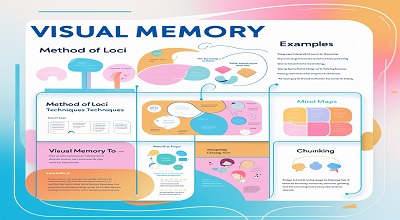Visual Memory Techniques
Visual Memory Techniques: In today’s fast-paced academic environment, students and professionals alike are constantly seeking effective ways to retain and recall information. One of the most powerful methods for enhancing memory is through visual memory techniques. These techniques leverage the brain’s natural ability to process and remember images more efficiently than text alone.
This comprehensive guide explores the latest visual memory techniques for studying, complete with practical examples and scientific backing. Whether you’re a student preparing for exams, a professional learning new skills, or an educator looking to improve teaching methods, these strategies will help optimize learning and retention.
What is Visual Memory?
Visual memory refers to the brain’s ability to store and retrieve visual information. It plays a crucial role in learning, as images are processed 60,000 times faster than text by the human brain (Source: MIT Neuroscience). There are two main types of visual memory:
- Short-term visual memory: Holds images for a few seconds (e.g., remembering a phone number just seen).
- Long-term visual memory: Retains images for extended periods (e.g., recalling a childhood home).
By harnessing visual memory techniques, learners can improve recall speed and accuracy.
Why Visual Memory Techniques Work
Research in cognitive psychology suggests that:
- The Picture Superiority Effect: People remember 65% of visual information even after three days, compared to only 10% of written or spoken information (Source: Brain Rules, John Medina).
- Dual Coding Theory: Combining verbal and visual information enhances memory retention (Paivio, 1971).
- Engagement Boost: Visuals stimulate the brain’s occipital lobe, making learning more interactive and memorable.
Top Visual Memory Techniques for Studying with Examples
A. The Method of Loci (Memory Palace)
How it works: Associate information with specific locations in a familiar place (e.g., your home).
Example: To memorize a grocery list:
- Imagine milk spilled on the front door.
- Bananas hanging from the chandelier.
- Bread on the sofa.
Latest Application: Medical students use this to memorize anatomy.
B. Mind Mapping
How it works: Create a diagram connecting central ideas with branches.
Example: For an essay on “Climate Change”:
- Central node: “Climate Change”
- Branches: Causes (Deforestation, Fossil Fuels), Effects (Rising Sea Levels, Extreme Weather), Solutions (Renewable Energy, Policy Changes)
Tool: Use MindMeister or XMind.
C. Flashcards with Visual Cues
How it works: Pair terms with relevant images.
Example: Learning Spanish:
- Word: “El perro” (The dog) → Image of a dog.
Tool: Anki (spaced repetition).
D. Symbolic Representation
How it works: Replace abstract concepts with symbols.
Example: In Physics, “E=mc²” can be drawn as an energy explosion.
E. Color-Coding Information
How it works: Assign colors to categories.
Example: History notes:
- Blue = Dates
- Red = Important Figures
- Green = Key Events
F. Infographics and Diagrams
How it works: Summarize complex data visually.
Example: Biology – “Photosynthesis Process” as a flowchart.
G. Sketch Notes (Doodle Notes)
How it works: Combine drawings with handwritten notes.
Example: Literature – Sketch Shakespeare’s characters with quotes.
H. Chunking with Visual Patterns
How it works: Group information into visual clusters.
Example: Memorizing phone numbers as XXX-XXX-XXXX instead of a long string.
I. Storytelling with Images
How it works: Create a visual narrative.
Example: Learning history – Draw a comic strip of World War II events.
J. The Peg System
How it works: Associate numbers with images.
Example: 1 = Sun, 2 = Shoe, 3 = Tree, etc.
Scientific Evidence Supporting Visual Memory Techniques
- A Harvard study found that students using visual aids scored 25% higher on tests.
- Neuroscience research shows that visuals activate the hippocampus, enhancing long-term memory.
How to Apply Visual Memory Techniques in Different Subjects?
Mathematics
- Use graphs & geometric shapes to solve equations.
Science
- Biology: Draw cell structures.
- Chemistry: Color-code the periodic table.
History
- Timeline infographics.
Languages
- Visual flashcards for vocabulary.
Literature
- Character mind maps.
Digital Tools for Enhancing Visual Memory
| Tool | Purpose |
|---|---|
| Anki | Spaced repetition flashcards |
| Canva | Create infographics |
| MindMeister | Digital mind maps |
| Notability | Sketch notes on tablets |
| Quizlet | Interactive flashcards |
Common Mistakes to Avoid
- Overloading visuals → Keep them simple.
- Ignoring repetition → Review visuals periodically.
- Using irrelevant images → Ensure visuals match content.
Case Studies
- Medical Student Success: A student used Memory Palace to memorize 300+ anatomy terms in a week.
- Language Learner: Improved Spanish recall by 40% using visual flashcards.
FAQs (Frequently Asked Questions)
Q1: How long does it take to see results with visual memory techniques?
A: Most learners notice improvement within 2-4 weeks of consistent practice.
Q2: Can visual memory techniques help with exams?
A: Yes! They enhance recall speed, perfect for timed tests.
Q3: Are digital tools better than handwritten visual notes?
A: Both work, but handwriting can boost memory due to motor engagement.
Q4: Do visual techniques work for all learning styles?
A: Primarily for visual learners, but combining with auditory/kinesthetic methods helps others.
Q5: How can teachers incorporate these techniques in classrooms?
A: Use mind maps, infographics, and doodle notes in lessons.
Conclusion
Visual memory techniques are powerful, science-backed tools for improving study efficiency. From Mind Mapping to Memory Palaces, these strategies cater to diverse learning needs. By integrating them with digital tools, students and professionals can achieve faster, longer-lasting recall.
Free Download Link: NBA 2K25 MOD APK
